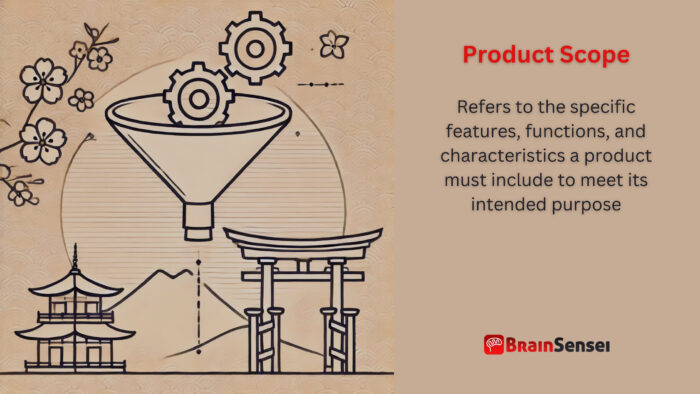
Product Scope
What is Product Scope?
Product scope refers to the specific features, functions, and characteristics a product must include to meet its intended purpose. It outlines the product’s delivery, including design specifications, user requirements, and performance expectations. Product scope is crucial in project management, ensuring alignment between stakeholder expectations and final deliverables.
Key Takeaways
- Product scope defines the features and functionalities of a product.
- It is distinct from the project scope, which covers the work required to develop the product.
- A well-defined product scope reduces scope creep and misalignment with stakeholder expectations.
- It is a reference for product development, quality assurance, and performance evaluation.
- Effective product scope management involves documentation, validation, and control mechanisms.
Understanding Product Scope
How It Works
Product scope is established during the early stages of product development and remains a guiding framework throughout the lifecycle. It includes detailed descriptions of product attributes, performance requirements, and constraints. Clear documentation of product scope ensures that teams stay focused on the intended outcomes while avoiding unnecessary deviations.
Key Components of Product Scope
- Product Features: The core functionalities that the product must have
- Technical Specifications: Design, architecture, and technology requirements
- User Requirements: Expectations and needs of the target audience
- Quality Standards: Performance benchmarks and compliance requirements
- Constraints & Assumptions: Limitations such as budget, technology, or resources
Notes
- Product scope should be reviewed and validated by stakeholders to ensure alignment.
- Adding new features without proper evaluation causes scope creep.
- A change management process should control changes in product scope.
- Proper documentation prevents misunderstandings and project delays.
- A product scope statement helps maintain clarity and direction for development teams.
Related Terms
- Project Scope: Defines the overall work required to complete a project, including product scope.
- Scope Creep: The uncontrolled expansion of a product’s features beyond the initial scope.
- Requirements Management: Process of defining, documenting, and maintaining product requirements.
- Product Roadmap: Outlines the product vision, goals, and key milestones.
- Minimum Viable Product (MVP): The most essential product version that delivers core functionality.
- Quality Assurance (QA): Ensuring the product meets defined quality standards.
Examples of Product Scope in Different Industries
Manufacturing Industry – Automobile Development
A car manufacturer defining the product scope for a new electric vehicle may include battery range, charging capabilities, safety features, and interior design specifications. Ensuring these attributes align with customer needs and regulatory standards is critical to successful product development.
In this case, the company must first define the target market, considering affordability, luxury, or performance. The scope will outline specifics such as battery technology (lithium-ion vs. solid-state), driving range per charge, fast-charging capabilities, vehicle safety features, and autonomous driving support. Additionally, the product scope must include environmental compliance, ensuring adherence to emissions standards and government incentives for electric vehicle adoption. By adequately defining these factors, the manufacturer can align design, production, and marketing strategies with consumer expectations and industry regulations.
Software Industry – Mobile Application
A company developing a fitness tracking app must define its core functionalities, such as step tracking, heart rate monitoring, and integration with wearable devices. The product scope includes UI/UX design, platform compatibility, and data security measures.
For example, if the app targets athletes and fitness enthusiasts, it may need to incorporate GPS tracking for outdoor activities, personalized workout recommendations, and AI-based health analytics. Security requirements—data encryption, user authentication, and GDPR compliance—define a key component of the product scope. Additionally, determining whether the app will be subscription-based or offer in-app purchases is essential in shaping development efforts. By clearly outlining these aspects, developers can create a scalable and feature-rich application that meets user expectations and industry regulations.
Healthcare Industry – Medical Device Development
A medical device company designing a glucose monitoring system must define accuracy requirements, connectivity options, and compliance with FDA regulations. The product scope ensures that the final device meets industry standards and user needs.
For example, a non-invasive glucose monitoring device may need to define performance benchmarks such as response time, accuracy margin, and real-time data synchronization with mobile health apps. The product scope would also cover usability features such as a user-friendly display, wireless data transfer capabilities, and battery life optimization. Additionally, compliance with global health regulations (FDA, CE marking, ISO standards) is crucial for ensuring market approval and consumer trust. By documenting these requirements, companies can streamline development efforts, minimize compliance risks, and accelerate time-to-market.
A well-structured product scope improves quality, customer satisfaction, and regulatory adherence. Meeting industry-specific requirements ensures the final product delivers the intended functionality.
Use Cases of Product Scope Worldwide
North America (E-Commerce)
A retail company in the United States launching an e-commerce platform must outline product scope elements such as payment gateway integration, product catalogue functionality, and customer support features. Proper scope management ensures the project stays on schedule and within budget. The company must also determine how to handle user data, regulatory compliance, and integration with third-party logistics providers. Documenting these elements prevents the project team from misalignment with stakeholders and unexpected delays.
Europe (Pharmaceutical)
A European pharmaceutical company developing a new drug must define the chemical composition, clinical trial requirements, and regulatory approvals as part of the product scope. Failure to control scope changes could lead to extended approval timelines and increased costs. The company must also account for variations in regional regulations across different European markets. Adhering to Good Manufacturing Practices (GMP) and ensuring proper clinical testing protocols will prevent non-compliance risks and delays in product launches.
Asia (Telecommunications)
A telecommunications provider developing a 5G-enabled smartphone in Asia must define network compatibility, processing power, and security features. Managing product scope ensures that the device meets market demands and competitive standards. The provider must also ensure compliance with different mobile network standards in various Asian countries. Addressing software optimization, battery efficiency, and the inclusion of AI-powered features will enhance the product’s appeal to a tech-savvy market. By carefully planning product scope, the company can maintain cost efficiency while delivering high-performance devices to consumers.
Best Practices for Managing Product Scope
Project managers must strategically manage product scope to ensure all features and functionalities align with business goals. Here are some best practices to follow:
Define Clear Objectives
Before initiating a product development process, teams should establish a well-defined objective. A well-defined objective helps maintain clarity and ensures all stakeholders align with the final product vision. Clearly outlining functional requirements and expected outcomes minimizes misunderstandings and enhances efficiency.
Document Scope in Detail
A detailed product scope statement is crucial for avoiding misinterpretations and inconsistencies. The document should specify key functionalities, technical specifications, and limitations. This comprehensive documentation is a reference throughout the development cycle and ensures teams remain aligned with the product’s intended purpose.
Control Scope Changes
Change requests are inevitable in product development, but unregulated changes can cause scope creep. Implementing a change control process ensures project teams carefully evaluate any modifications before incorporating them. This best practice helps maintain project timelines and budgets while keeping product goals intact.
Engage Stakeholders
Successful product scope management requires continuous communication and collaboration among stakeholders. Regular check-ins and feedback loops ensure the product meets expectations and identifies potential roadblocks early. Engaging users, developers, and executives throughout development fosters transparency and improves decision-making.
Use Prototyping and Testing
Prototyping and iterative testing enable teams to validate product features and gather user feedback before finalizing development. This approach helps refine functionalities, optimize user experience, and mitigate risks associated with poor product-market fit. Teams should conduct testing in multiple phases to ensure the final product meets all predefined criteria.
Prioritize Features Based on Value
Not all features contribute equally to a product’s success. Prioritizing functionalities based on customer needs and market demand ensures that the most impactful features receive the necessary resources. Techniques like the MoSCoW method (Must-have, Should-have, Could-have, Won’t-have) can aid in feature prioritization.
Monitor Performance and Adjust as Needed
Product scope management doesn’t end with development; continuous monitoring of product performance is essential. Teams should track user engagement, system performance, and customer satisfaction metrics and make necessary adjustments to ensure long-term success.
By adhering to these best practices, organizations can create a structured and efficient approach to managing product scope, ultimately leading to higher quality products, improved stakeholder satisfaction, and successful market adoption.
Product Scope: Common Mistakes and Issues
Managing product scope effectively is critical to delivering a successful product. However, several common mistakes can derail a project, leading to increased costs, delays, and reduced quality. Below are some of the most frequent issues and challenges encountered in product scope management.
Scope Creep
Scope creep happens when stakeholders introduce additional features or requirements beyond the initially defined product scope. Evolving stakeholder demands, poor change control processes, or a lack of clear documentation often cause this. For example, continuously adding new functionalities without reassessing the timeline and resources in software development can lead to project delays and budget overruns.
How to Prevent Scope Creep
- Clearly define and document product scope from the outset.
- Implement a strict change management process.
- Engage stakeholders early and set clear expectations.
- Prioritize feature additions based on their impact and feasibility.
Poor Requirement Definition
A vague or incomplete definition of product requirements can confuse teams, leading to misalignment and rework. If developers, designers, and project managers do not understand the product’s features and functionalities, the final product may not meet customer expectations.
How to Address Poor Requirement Definition
- Conduct detailed requirement-gathering sessions with stakeholders.
- Use visual aids such as wireframes, prototypes, and user stories.
- Validate requirements through user testing and iterative feedback loops.
- Maintain a comprehensive requirement document as a reference throughout the project lifecycle.
Inadequate Stakeholder Involvement
Product scope management requires active participation from all key stakeholders, including customers, business leaders, developers, and end-users. Failure to involve stakeholders in decision-making can result in products that do not align with business objectives or market needs.
How to Ensure Proper Stakeholder Involvement
- Organize regular meetings and updates to keep stakeholders informed.
- Utilize surveys and focus groups to gather input from target users.
- Foster open communication channels to discuss concerns and expectations.
- Assign a dedicated product owner to bridge the gap between business needs and technical execution.
Lack of Change Control Mechanisms
Even minor adjustments can disrupt the development process without a formal process for assessing and managing changes. Teams may struggle with shifting priorities, resulting in wasted effort and inconsistent product features.
How to Implement Effective Change Control
- Establish a change request process with proper documentation.
- Evaluate the impact of requested changes before approval.
- Ensure all modifications align with the original product vision.
- Communicate changes across teams to prevent misunderstandings.
Unrealistic Timelines and Resource Allocation
Poor planning can lead to overpromising and underdelivering. Failure to realistically assess product scope against available resources and deadlines causes teams to struggle with excessive workloads, reduced quality, and unmet expectations.
How to Avoid Unrealistic Timelines
- Conduct thorough project planning with realistic milestone estimations.
- Allocate resources based on capacity and skill sets.
- Use agile methodologies to allow for iterative development and adjustments.
- Continuously monitor progress and adjust plans as needed.
Ignoring User Feedback
Neglecting user feedback throughout the product development process can result in a product that does not meet customer expectations. Failing to incorporate insights from early adopters and beta testers may lead to costly redesigns after launch.
How to Incorporate User Feedback Effectively
- Conduct usability testing at different development stages.
- Analyze customer behaviour and feedback through analytics tools.
- Create feedback loops to improve product features iteratively.
- Implement A/B testing to assess user preferences before finalizing designs.
Misalignment Between Teams
Product development involves multiple teams, including marketing, engineering, design, and sales. If these teams do not share a common understanding of the product’s scope, inconsistencies may arise, affecting the final product’s quality and usability.
How to Ensure Cross-Team Alignment
- Use project management tools to track progress and maintain transparency.
- Establish clear roles and responsibilities for each team.
- Foster interdepartmental collaboration through joint planning sessions.
- Regularly review development milestones to ensure consistency.
Conclusion: Avoiding these common mistakes in product scope management requires proactive planning, continuous communication, and adherence to best practices. Organizations can mitigate risks and deliver high-quality products that meet market demands by clearly defining scope, involving stakeholders, implementing change control mechanisms, and leveraging user feedback. Addressing these challenges early on will enhance efficiency, reduce costly rework, and improve overall project success.
Product Scope: Frequently Asked Questions (FAQs)
How does product scope differ from project scope?
The product scope focuses on the features and functionality the product will deliver, whereas the project scope includes all the work required to develop, test, and deploy the product.
Why is product scope essential?
A well-defined product scope prevents misalignment with stakeholder expectations, minimizes rework, and helps keep projects on schedule and within budget.
How can product scope be controlled?
The project team can manage the product scope through proper documentation, stakeholder engagement, and a structured change management process that evaluates modifications.
What is scope creep, and how does it affect product scope?
Adding unplanned features or requirements without assessing their impact causes scope creep. It leads to budget overruns and project delays.
Can product scope change during development?
Yes, but changes should be formally reviewed and approved to align with the overall product goals and resource constraints.
Additional Resources
Preparing for a PMI certification?
- Exam Prep Courses: PMP®, CAPM®, and PMI-ACP®
- Exam Simulators: PMP®, CAPM®, PMI-ACP®, PMI-PBA®, PMI-RMP®, PMI-SP®, PgMP®, and PfMP®
- Professional Development Units (PDUs): 15, 30, and 60 PDU Bundles



